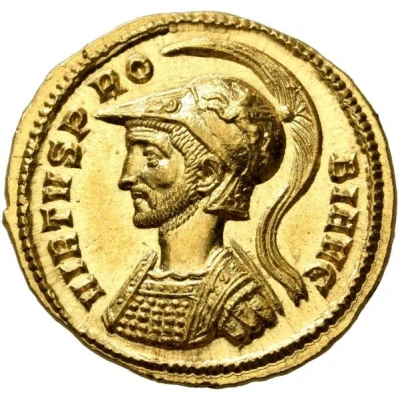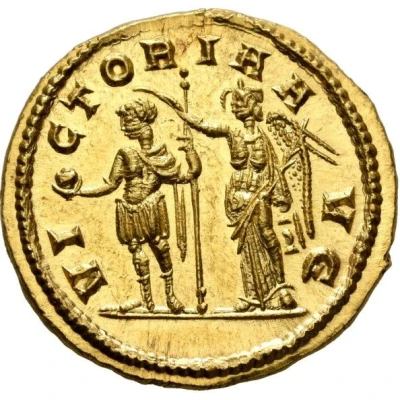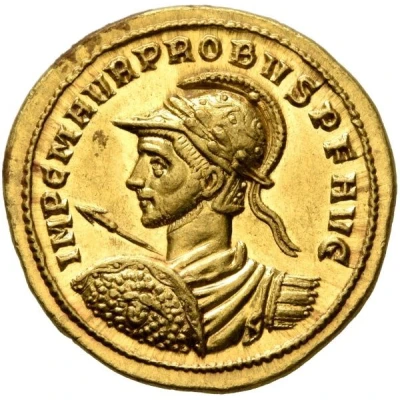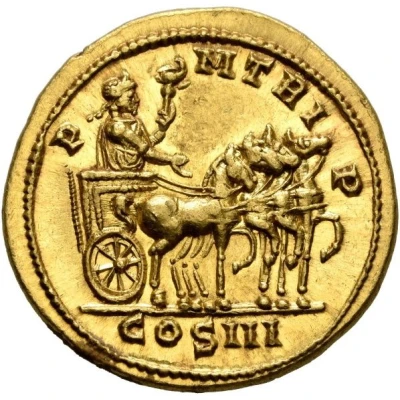


© Leu Numismatik
Aureus - Probus VICTORIA AVG; Siscia
279 year| Gold | 6.37 g | 20 mm |
| Issuer | Rome › Roman Empire (27 BC - 395 AD) |
|---|---|
| Emperor | Probus (Marcus Aurelius Probus) (276-282) |
| Type | Standard circulation coin |
| Year | 279 |
| Value | Aureus (25⁄2) |
| Currency | Antoninianus, Reform of Caracalla (AD 215 – 301) |
| Composition | Gold |
| Weight | 6.37 g |
| Diameter | 20 mm |
| Shape | Round (irregular) |
| Technique | Hammered |
| Orientation | Variable alignment ↺ |
| Demonetized | Yes |
| Updated | 2024-10-05 |
| Numista | N#384750 |
|---|---|
| Rarity index | 100% |
Reverse
Probus standing front in military attire, head to left, holding globe in his right hand and scepter in his left, being crowned with wreath by Victory standing front behind him, holding palm frond in her left hand.
Script: Latin
Lettering: VI-CTORIA A-VG
Comment
Unpublished and probably unique.Boasting a magnificent military bust type on the obverse, the festive issue celebrates the victoriousness of the emperor, who is being crowned by Victory with a wreath on the reverse. The coin was struck in Siscia in early 279 to commemorate the emperor's victories against Gothic, Frankish, Alemannic, Burgundian and Vandal invaders in the previous years. A hitherto unrecorded type, the aureus is related to an offstrike in bronze from aureus dies with a similar reverse, but a differing bust type (Leo Benz Collection, Lanz 100, 22 November 2000, 424 = Sternberg 15, 11 April 1985, 619). The obverse type (but not the die) is known from aurei showing the emperor as a consul in a quadriga with the legend 'P M TRI P COS III'. This dates the entire issue to the beginning of 279, when Probus was heading back from the western provinces to the Danube frontier and on to Asia Minor, where he would deal with the Isaurian rebels under their charismatic leader, Lydius.
Perhaps the most impressive aspect of this wonderful coin is the incredibly detailed pseudo-Corinthian helmet, decorated with a winged horse springing to left on the bowl and a tiny, but clearly noticeable ram's head on the visor. Few Roman parade helmets have survived, the most famous of which is perhaps a cavalry helmet dated to circa 150-250 and found in the Iciniacum (Theilenhofen) fortress on the Upper Germanic-Rhaetian Limes. This is a different type of helmet, worn by auxiliary soldiers on parade, but it is also richly decorated, with springing lions adorning the sides of the bowl, eagles holding a wreath on the cheek guards, and the central crest ending in a bold facing eagle showing his wings in full display. Naturally, the emperor's own parade helmet would have been even more luxurious, and likely decorated with gold and precious stones, some of which are perhaps indicated by the four small pellets appearing on Probus' neck guard on our coin. Clearly such valuable helmets were not worn in actual battle, where protection would have been key, but they were proudly paraded on festive occasions such as military parades.
Interesting fact
One interesting fact about the Aureus - Probus (VICTORIA AVG; Siscia) coin is that it features a unique blend of Roman and Greek influences in its design. The obverse side of the coin depicts the Roman emperor Probus, while the reverse side features a representation of the goddess Victoria, who was revered by both the Romans and Greeks. This blending of cultural influences reflects the diverse and multicultural nature of the Roman Empire during its time.

